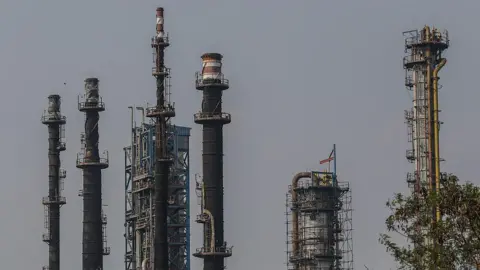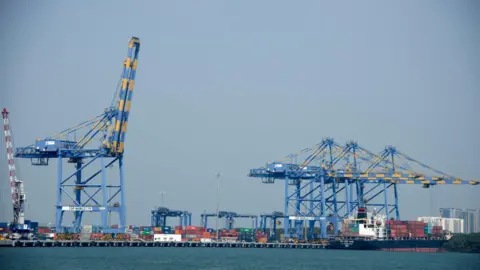US President Donald Trump’s decision to impose 25% tariffs on goods imported from India could hit the country’s growth prospects, experts say.
It is unclear how big the hit could be, given that Trump has announced an unspecified penalty in addition to the 25% tariff rate.
In a post on his Truth Social platform on Wednesday, Trump said the penalty would be imposed on India starting 1 August for buying Russian oil and weapons “at a time when everyone wants Russia to STOP THE KILLING IN UKRAINE”.
Experts say further details on the fine print of the penalty will be crucial to determine the actual economic impact of the decision.
“The tariff (and penalty) now proposed by the US is higher than what we had anticipated and is therefore likely to pose a headwind to India’s GDP growth. The extent of the downside will depend on the size of the penalties imposed,” Aditi Nayar, chief economist at ratings agency Icra, said in a statement.
Icra had previously reduced its gross domestic product (GDP) forecast for India for this financial year from 6.5% to 6.2% due to the adverse impact of the tariff hikes.
Another brokerage Nomura said the tariffs were “growth negative” and India’s GDP could take a hit of 0.2% as a result of the announcements.
Indian stock markets reacted negatively to the news, opening in the red as trade began for the day.
“The market was expecting a tariff deal to work out as longer term US-India strategic interests are aligned,” said Nilesh Shah, a fund manager.
India and the US have held several rounds of negotiations for a trade deal over the past few months, with Delhi even reducing tariffs on goods like Bourbon whiskey and motorcycles to placate the US. But the US runs a $45bn (£33bn) trade deficit with India, which Trump is keen to reduce.

A 25% tariff plus additional penalties will leave India worse off relative to other Asian economies like Vietnam and China, “the main countries we are competing against for investment and industrialisation”, Rahul Ahluwalia of the Foundation for Economic Development think-tank told the BBC.
US tariffs on Chinese imports fell from 145% to 30% after negotiations in Geneva and London. The two sides now have until 12 August to reach a long-term trade deal. Trump also inked a deal with Vietnam in early July, agreeing to levy tariffs of 20% compared with a 46% levy proposed in April.
Given that India’s tariffs are no longer lower than these countries, an expected diversion of export supply chains in sectors like textiles to India is now unlikely.
“If the tariff is sustained, this move may directly affect key sectors such as marine products, pharmaceuticals, textiles, leather and automobiles, where bilateral trade has been especially robust,” said Agneshwar Sen, trade policy expert at EY India.
- Trump to hit India with 25% tariffs – plus ‘penalty’ for trade with Russia
- Is the ‘big, beautiful’ India-US trade deal in trouble?
Trump’s announcement evoked across-the-board reactions of disappointment and concern from economists, exporters and industry leaders in India.
“While this move is unfortunate and will have a clear bearing on our exports, we hope that this imposition of higher tariffs will be a short-term phenomenon and that a permanent trade deal between the two sides will be finalised soon,” Mr Harsha Vardhan Agarwal, president of industry body FICCI, said.
Dr Ajay Sahai, who heads a federation of Indian exporting organisations, said the tariffs will lead to fresh price negotiations between US buyers and Indian sellers to decide how much of the 25% hike exporters can absorb.
Tariffs are typically taxes charged on goods imported from other countries. Exporters are indirectly impacted by higher tariffs because these taxes make goods costly for end-consumers, and lead to reduced demand. This can force exporters to cut prices in order to remain competitive, impacting their margins.

In a press statement, India’s commerce ministry said it is studying the “implications” of Trump’s announcement.
India has reiterated that while the government remains committed to a mutually beneficial bilateral trade agreement, it attached “the utmost importance to protecting and promoting the welfare of our farmers, entrepreneurs, and MSMEs [micro, small and medium enterprises]”, – an indication that areas like agriculture, dairy and other politically sensitive sectors have become key sticking points that derailed the negotiations.
India’s opposition Congress party mounted a scathing attack on the government following the announcement.
In a post on X, the Congress said that while Prime Minister Narendra Modi campaigned for Trump – referring to a 2019 rally Modi held in the US – and hugged him like a long-lost brother, in return “Trump goes on to impose such harsh tariff on India. It is a catastrophic failure of foreign policy”.
Trump’s hyphenation of the trade deal with India’s economic relationship with Russia further “complicates the situation”, said Mark Linscott of the US India Strategic Partnership Forum and a former US government trade representative.
“They add a whole new dimension to the negotiations, and it’s not clear how this set of issues can be added to a trade package.”
Since the war in Ukraine began, India has resolutely defended its historic ties with Russia and also its oil purchases, saying that a country reliant on energy imports will buy oil at the best price possible to ensure that millions of poor Indians do not suffer. India’s dependence on Russian arms has also been gradually coming down.
Mr Linscott said despite the setbacks, both India and the US have substantial shared interests in restarting negotiations and concluding an interim deal. US is India’s largest foreign export market with bilateral trade amounting to $190bn and a stated goal to take it to $500bn in the years to come.
“The President insists on putting his stamp on every deal. For that to happen with India, I think it required Prime Minister Modi to reach out to negotiate the last elements directly with the President, including any headline commitments on purchases of energy and military equipment and investments in the United States. For whatever reason, that did not happen,” he added.
While Trump has called India a “good friend”, he has also repeatedly taken aim at India’s high tariffs. On Thursday morning, in a particularly acerbic post on his Truth Social platform, he said: “I don’t care what India does with Russia. They can take their dead economies down together, for all I care. We have done very little business with India, their Tariffs are too high, among the highest in the World.”
But despite the growing tensions, negotiations between India and the US are likely to continue through August, with a team from the US expected in India later next month to thrash out a comprehensive trade agreement.
The hope among many is that tariffs will get negotiated lower and the higher reciprocal tariff rate of 25% may be temporary, till a detailed trade deal with the US is secured. The two sides have set a fall deadline to conclude the deal.
But the best-case outcome would still be tariffs in the 15-20% range, “which is disappointing, considering India’s more advanced stage of negotiations”, said Nomura.
While the impact could be contained, given that the Indian economy is relatively more domestically oriented and less reliant on goods trade than other Asian peers, Nomura believes Trump’s decision could “increase the likelihood of monetary policy easing” and prompt India’s central bank to make deeper rate cuts to protect growth.













